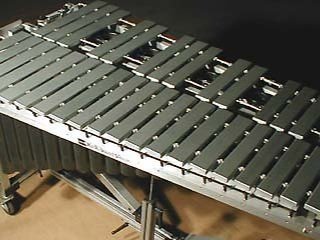Vibraphone & Marimba
K&K has almost 30 years experience in vibraphone amplification, more than any other company in the world. In fact, vibraphone amplification is the true origin of K&K. Our first product ever was a magnetic vibe pickup system.
The system consists of a number of small piezo ceramic transducer disks (pickups) which are glued to the nodal points of each bar. The nodal point is located on a fictive line to be drawn by connecting the string holes in the bar. With a fast drying cyan-acrylate glue (supplied), the pickups are attached to the bar's flip side on the outside end (opposite end of the damper). The single pickup disk has a half-inch diameter and is only 0.027 inches (0.7 mm) thin. The transducers are plugged into whole tone and half tone collecting rails.
Our vibraphone amplification system is designed for 3 octave vibraphones, but we can custom fit it to almost any vibraphone model on the market.
Systems Available:
Straight-Rail Vibraphone Amplification System, where the rails are permanently attached to the frame rail of the instrument with two screws each.
Split-Rail Vibraphone Amplification System, for traveler-type vibraphones, equipped with hangers for easy transport.
Our Marimba System is equipped with hangers as well. For a full size (4 1/3 octave) marimba you will receive 4 collecting rails. Inside all rails, trim pots permit volume adjustment of each bar by using a small screw driver.
Order accessories and replacement parts for existing vibraphone systems.
-
The three octave sections of the vibraphone's tone range (F-F, F#-E, F-F on the vibe and A-B, C-B, C-C/2 octaves on a 4 1/3 oct. marimba) can be separately adjusted with the supplied three-channel Mini Mixer. It provides a mono line out as well as three separate octave outputs. These octave outputs allow an impressive stereo surround sound effect by setting the low octave to the left, mid octave in the center, and high octave to the right speaker. Volume, bass, and treble can be adjusted separately for each of the three octave channels. This provides a perfect balance over the complete tone range plus a truly voluminous bass octave and a crystal clear high octave sound. A basic adjustment is already preset.
-
You can easily install the system by yourself. It takes approximately two hours. All installation materials, such as glue, sand paper, etc., plus detailed instructions are supplied. K&K also offers installation in their factory in Coos Bay, Oregon if you like to send your bars in. The pickups will not alter the acoustic sound of the vibraphone or marimba when properly mounted.
-
Before buying an appropriate amplifier or effect unit, you should test it with your instrument at sufficient volume. Standard combo amplifiers (e.g. for guitar) usually cannot tolerate the enormous peak level and amplitude of the vibraphone and thus produce distortion. We recommend power combo amps above 100 watts. For example, the Roland Jazz Chorus Combo Amplifier is a good choice.
You can also achieve great results with bass combo amps or bass amplifiers combined with a full range cabinet. Compared to guitar amps with identical watts, they tolerate far more impulse peaks and work free of distortion at higher volumes.
If a mixing console or PA system is available, it is imperative not to overdrive the input channel. Please make sure the red peak light never lights up! Sufficient PA power amplification (200-300 watts minimum) is required to achieve high distortion free volumes.
-
With the amplified vibraphone you need to recreate the vibrato effect with an effects unit, as the pickup system does not pick up the resonator tubes or the vibrato flaps. Many of the effect pedals used for electric guitars may be inappropriate due to their insufficient peak tolerance. We recommend you look for a multi-effect unit with a minus 20 dB switch or adjustable input gain. This allows for successful use with the vibraphone pickup system. We've found that the best effect unit to be combined with the vibraphone or marimba is the Eventide Pitch Factor. Another good one is the TC Chorus Flanger, which produces a very spacy, soft stereo vibrato effect for the vibe. A good quality digital reverb is another useful effect for the electric vibraphone or marimba.
-
Generally, musicians can use their favorite mallets when playing the electric vibraphone or marimba. Their influence on the electric sound is comparable to acoustic playing. For example, David Friedman plays very heavy mallets while Mike Mainieri plays much lighter ones. In our experience, medium to light mallets will render the most lucid and voluminous results. They allow driving a larger dynamic range on the amp side and thus avoid overdriving the amp's input section. A major consequence of an amplified mallet instrument is the improved dynamic, especially when performing with a band. When using microphones, these dynamics are often sacrificed as it becomes necessary to play as loud as possible at all times, just to be heard at all.
Sound Samples
Vibraphone Pickup and Midi System played by David Friedman and Thomas van der Geld. Recorded in 1992 in Bremen Germany at Studio Thein. No mics were used. MP3 converted on Cakewalk Pro Audio 9 software.
Video by Innokenty Ivanov. Innokenty is playing an older Premier vibraphone and we made a custom system for it. The vibe has a very different frame (metal tubes) than pretty much any other vibe model and we made a system where the collecting rails hang below the frame tubes. Please note that he does not use the tube resonators for this recording. This video demos the latest system with the new Mini Mixer.

